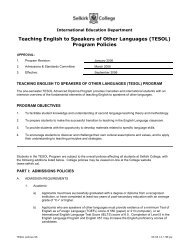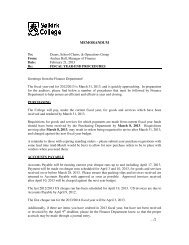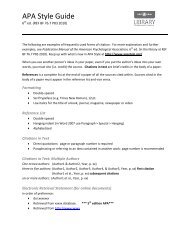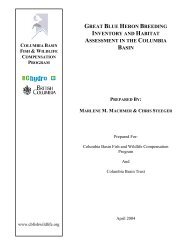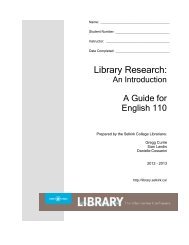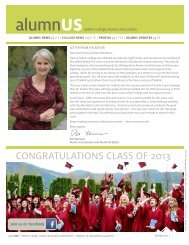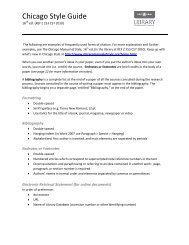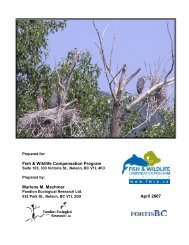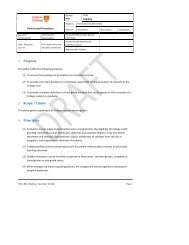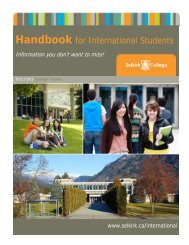selk irk.ca - Selkirk College
selk irk.ca - Selkirk College
selk irk.ca - Selkirk College
Create successful ePaper yourself
Turn your PDF publications into a flip-book with our unique Google optimized e-Paper software.
University Arts and Sciences Course Descriptions<br />
organic chemistry is surveyed; topics include the<br />
physi<strong>ca</strong>l and chemi<strong>ca</strong>l properties of alkanes and<br />
alkenes, stereochemistry, and addition, substitution,<br />
and elimination reactions. The laboratory<br />
work involves the measurement of physi<strong>ca</strong>l and<br />
chemi<strong>ca</strong>l properties as well as chemi<strong>ca</strong>l syntheses.<br />
CHEM 110 or CHEM 122 with a grade of<br />
“C” or better, or written permission of the<br />
Instructor and School Chair.<br />
CHEM 211 Introductory<br />
Analyti<strong>ca</strong>l Chemistry<br />
CHEM 211 - Introductory Analyti<strong>ca</strong>l Chemistry,<br />
introduces students to the basics of quantitative<br />
analysis. Propagation of experimental error and<br />
the statisti<strong>ca</strong>l analysis of repli<strong>ca</strong>te measurements<br />
will be used to assess the reliability of analyti<strong>ca</strong>l<br />
results. Spreadsheets will be used to make manipulation<br />
of large pools of data more manageable.<br />
Specific analyti<strong>ca</strong>l techniques to be investigated<br />
include titrimetry, electrochemistry, spectrophotometry<br />
and chromatography. In the lab, students<br />
will learn to make measurements that are both<br />
accurate and precise, and will analyze samples<br />
using the techniques listed above.<br />
CHEM 125 with a grade of C or better, or<br />
with written permission of the Instructor<br />
and School Chair.<br />
This course is currently not running. Contact<br />
the program for more information.<br />
CHEM 212 Organic Chemistry I<br />
CHEM 212, Organic Chemistry I, explores the<br />
relationship between the structures of <strong>ca</strong>rboncontaining<br />
molecules and their physi<strong>ca</strong>l and<br />
chemi<strong>ca</strong>l properties. Some topics from first year<br />
general chemistry are reviewed briefly:<br />
alkanes, stereochemistry, alkenes, and nucleophilic<br />
substitution and elimination reactions of alkyl<br />
halides. The correlation between structure and<br />
acidity is investigated, and the chemistry of alkynes<br />
and alcohols is examined. Structure-determination<br />
techniques, including IR and NMR, are explored.<br />
The laboratory work of this course provides<br />
practi<strong>ca</strong>l experiences with separation/purifi<strong>ca</strong>tion<br />
techniques, molecular synthesis, and qualitative<br />
analyti<strong>ca</strong>l methods applied to organic compounds.<br />
CHEM 125 with a grade of “C” or better, or<br />
written permission of the Instructor and<br />
School Chair.<br />
CHEM 213 Organic Chemistry II<br />
This organic chemistry course is a continuation<br />
of CHEM 212. The survey of organic families is<br />
continued with a study of aromatic compounds,<br />
alcohols, ethers, aldehydes and ketones, as well as<br />
<strong>ca</strong>rboxylic acids and <strong>ca</strong>rboxylic acid derivatives. The<br />
chemistry of a variety of compounds of biologi<strong>ca</strong>l interest<br />
is also discussed. The laboratory work involves<br />
synthesis and organic structure determination.<br />
CHEM 212 with a grade of “C” or better.<br />
CHEM 220 Introductory<br />
Inorganic Chemistry<br />
In this introductory inorganic chemistry course<br />
the elemental and molecular properties of matter<br />
are examined using modern concepts of atomic<br />
structure and bonding. Coordination chemistry is<br />
presented in detail through nomenclature, structure<br />
and bonding theories, physi<strong>ca</strong>l and chemi<strong>ca</strong>l<br />
properties, preparations and reactions for typi<strong>ca</strong>l<br />
compounds. The laboratory work combines<br />
qualitative, quantitative and spectrophotometric<br />
analyses with the synthesis of a coordination<br />
compound.<br />
CHEM 125 and Math 101 each with a grade<br />
of “C” or better.<br />
This course is currently not running. Contact<br />
the program for more information.<br />
CHEM 222 Introductory<br />
Physi<strong>ca</strong>l Chemistry<br />
In this introductory physi<strong>ca</strong>l chemistry course<br />
the basic concepts of chemi<strong>ca</strong>l thermodynamics<br />
and equilibria are presented. The properties of<br />
solutions, electrochemi<strong>ca</strong>l reactions, acidic and<br />
basic systems are examined. The principles of<br />
reaction kinetics are introduced. In the laboratory,<br />
some quantitative properties of physicochemi<strong>ca</strong>l<br />
systems are measured.<br />
CHEM 125 and MATH 101 each with a grade<br />
of “C” or better, or written permission of the<br />
Instructor and School Chair.<br />
Computer Science<br />
CPSC 100 Introduction<br />
to Programming I<br />
An introductory object-oriented (OO)<br />
programming course with emphasis on basic<br />
programming constructs, algorithms, program<br />
design, and good programming practices. This<br />
course will introduce a high-level language to<br />
illustrate programming basics. Students will<br />
develop and test small OO programs which<br />
loop, make decisions, access arrays, define classes,<br />
instantiate objects, and invoke methods.<br />
MATH 12 or 051 or Math 130 each<br />
with a grade of “C” or better.<br />
CPSC 101 Introduction<br />
to Programming II<br />
This course is a continuation of CPSC 100<br />
with emphasis on more advanced programming<br />
techniques and design, development and test of<br />
large appli<strong>ca</strong>tions. Students will write programs<br />
which make use of library functions to display<br />
graphi<strong>ca</strong>l user interfaces, manage collections of<br />
data, access files and databases, and interact with<br />
other programs.<br />
CPSC 100 with a grade of “C” or better.<br />
CPSC 132 Computer<br />
Appli<strong>ca</strong>tions for Business<br />
This survey course, intended for Business<br />
Administration students, provides a general<br />
introduction to computer concepts and terminology,<br />
and the current and future use of computers<br />
in the business world. Students will learn the<br />
fundamentals of Microsoft Office appli<strong>ca</strong>tions in<br />
the lab sessions. Course delivery is mixed-mode:<br />
lectures will be delivered online, while labs will<br />
take place face-to-face in the computer labs.<br />
This course does not serve as a prerequisite for<br />
further computing science courses.<br />
ENGL 12 or equivalent with a grade of<br />
“C” or better or written permission of the<br />
Instructor and School Chair.<br />
CPSC 140 Elements of Computing<br />
This survey course, intended for non-specialists,<br />
provides a general introduction to computer<br />
concepts and terminology, and current and future<br />
use of computers. Common software appli<strong>ca</strong>tions<br />
and elementary programming concepts will be<br />
introduced. Course delivery is mixed mode:<br />
lectures will be delivered online, while labs will<br />
take place face-to-face in the computer labs.<br />
This course does not serve as a prerequisite for<br />
further computing science courses.<br />
ENGL 12 or equivalent with a grade of<br />
“C” or better or written permission of the<br />
Instructor and School Chair.<br />
CPSC 200 Computer Architecture<br />
and Program Design<br />
This course introduces computer architecture,<br />
internal data representation, digital logic, machine<br />
instructions, addressing concepts, memory<br />
management and an assembler language.<br />
CPSC 101 with a grade of “C” or better.<br />
Geography<br />
GEOG 130 Introduction to<br />
Physi<strong>ca</strong>l Geography<br />
Weather and climate, soils and vegetation,<br />
development of slopes and fluvial landforms with<br />
particular reference to western North Ameri<strong>ca</strong>.<br />
Principles of MATH 11 or equivalent with a<br />
grade of “C” or better or written permission<br />
of the Instructor and School Chair.<br />
GEOG 136 The Geography<br />
of British Columbia<br />
The appli<strong>ca</strong>tion of basic geographi<strong>ca</strong>l<br />
concepts and techniques to a study of<br />
British Columbia. The course includes<br />
a mandatory weekend field trip.<br />
ENGL 12 with a grade of “C” or better or<br />
written permission of the Instructor and<br />
School Chair.<br />
206 Selk<strong>irk</strong> <strong>College</strong> 12/13 School of University Arts and Sciences




